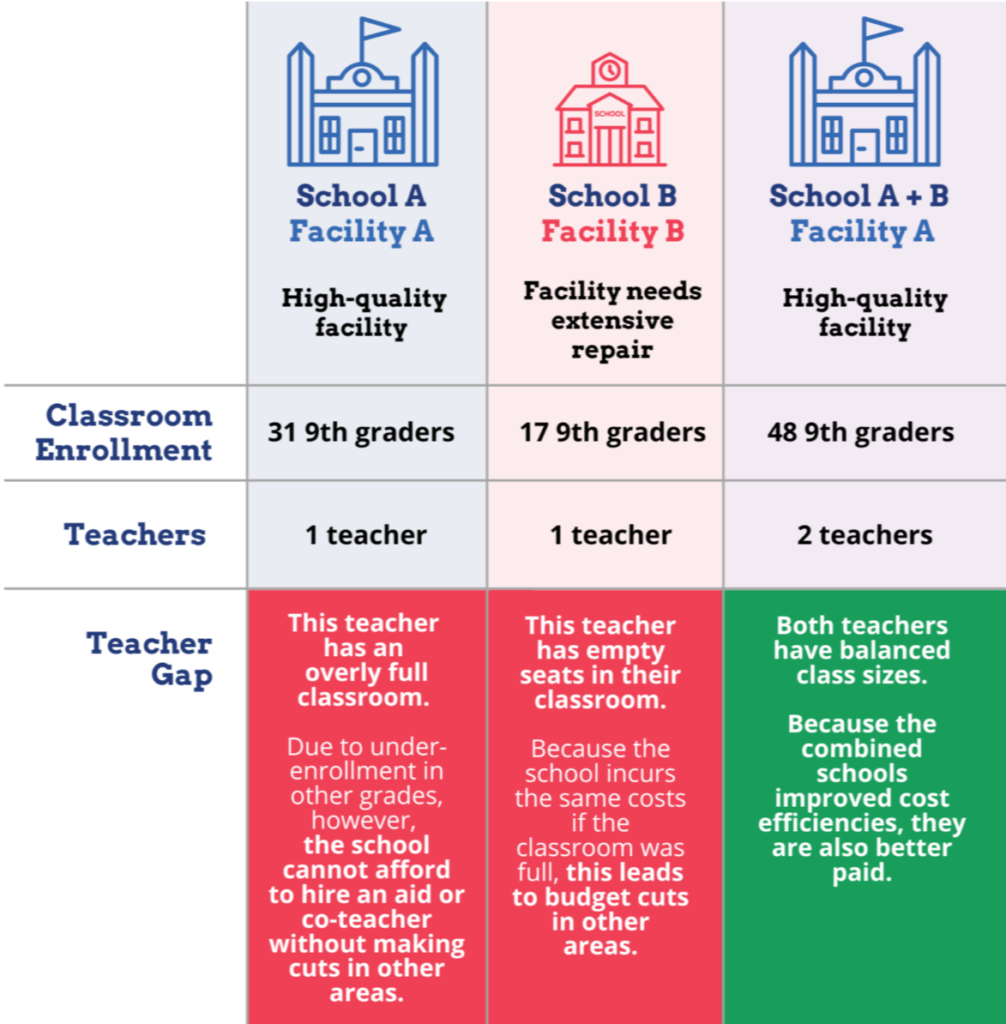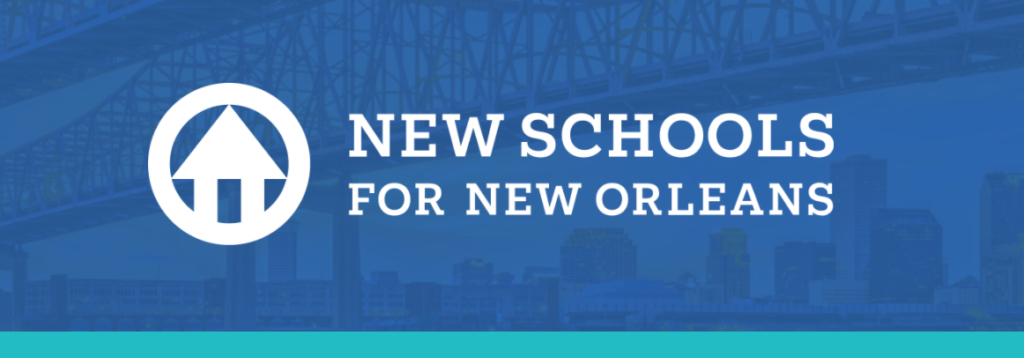To give students the resources they deserve, we have to shift our education landscape
New Orleans’ children deserve the very best education and opportunities. That requires amazing educators, great facilities and the most resources we can provide. But since enrollment is down in New Orleans’ schools, and funding is based on enrollment, some of our schools are already in a financial bind. They’re left making difficult decisions about where to spend limited funds. Other schools will start experiencing financial hardship in coming years as enrollment continues to decline and federal recovery dollars dry up.
In order to make sure every child has the resources they need, our system will need to make some significant changes, including school relocations, co-housing multiple schools in a single building, merging or consolidating schools, or, in some cases, closing schools. This will be difficult, but with the right support for students, families, and educators and enough time to prepare, we can ensure the changes are as smooth as possible. At NSNO, we are already working closely with schools and the district to help them grapple with what lowered enrollment means for them and how they can help address the problem.
The impact of lower enrollment differs based on the size of a school, its staff and resources, and the capacity and condition of the building it is in. Some schools, operating in facilities sized for a larger student body, are left spending limited resources on fixed costs like heating empty classrooms. Other schools may have the right sized space, but are left choosing between critical repairs and hiring an extra counselor. On a district level, lowered enrollment and the lower funding that comes with it limits the diverse options of school programs that families have come to expect.
This isn’t the first time New Orleans has faced a drop in enrollment. Between 2000 and 2004, for instance, the school system’s total enrollment dropped 15%. We’re also not the only city experiencing a decline right now, either. Oakland, California’s school board recently announced it will close, combine, or shrink eleven schools in the coming years. In Boston, where public school enrollment dropped by 15% between 2015 and 2022, multiple schools have closed as well. Denver, Colorado just announced that declining enrollment means they’ll need to close multiple schools in order to remain financially solvent.
As Orleans Parish School Board Vice President Carlos Zervigón recently shared, “We know school enrollment is shrinking in New Orleans due to shifts in population that are outside of anyone’s control. We didn’t cause these declines, but we also can’t ignore them. In order to sustain and improve funding and resources for our schools in future years, we have to prioritize careful, long-term, data-informed planning to ensure we provide an excellent, equitable education for all students.”
In many ways, New Orleans is better-positioned than most to address this challenge. Our thoughtful leaders, teams, and community members have created unique schools that are tailored to their students’ needs. Now, in addition to innovating around a curriculum or model, our system and schools will need to innovate around structure, facilities, and size. They will have to work together, as they did in years past on projects like creating a shared enrollment system and creating a “differentiated funding” formula that adjusted funding to students’ unique needs. This type of collaboration puts the needs of our students first.
Although school relocations, consolidations, and closures are difficult, they also present an opportunity to ensure all of our students are in quality facilities. Right now, New Orleans has around eighty school buildings–down from the 120 we had before Hurricane Katrina, when there were more people, and children, living in the city. As enrollment continues to decline, we will need even fewer buildings. And those we have span a wide range of quality. Some are state-of the-art, while others need significant repair. Currently, there are enough open seats in the district’s highest-quality facilities for every child in the lowest-quality school buildings to attend. This means that, with careful planning, we can make sure that all students get to learn in high-quality buildings.
There are many ways to make this a reality. If a school is too small for their high-quality facility, a school from a lower-quality building can move in and share the space. In some cases, schools may close so that their students move to a school where there are greater resources. These changes can be difficult, so we must do whatever we can to support students, families, and educators throughout.
Let’s imagine two schools that generally serve similar students and needs in a school year.

Some schools are already making these tough choices. Last year, two of our schools– Live Oak and Oscar Dunn–were voluntarily closed by their networks, Firstline Schools and IDEA, due in large part to low enrollment. These schools, the district, and nonprofit organizations like NSNO came together to support them. In 2021-22, “voluntary closures” like that of Oscar Dunn and Live Oak, as well as closures of the two schools that NOLA-PS did not renew, meant that an estimated 1,200 children in grades K-8 enrolled in other public schools this school year. This resulted in fewer under-enrolled schools, and therefore a greater balance of resources for each child. And the district’s “closing school priority” ensured that students enrolled at closing schools had the top choice to attend other K-8 schools citywide.
FirstLine CEO Sabrina Pence told us about her network’s choice.
“Closing a school is one of the hardest things that anyone can do. At FirstLine, our board had to courageously ask – will we be able to run a school that students deserve?” she says. “We knew that, because of low enrollment, we wouldn’t be able to run a well-rounded school where students have a wide variety of choices in electives, social workers, counselors, nurses and many other forms of support–a school that serves students in mind, body, and spirit. So, we chose to close our school so that our students could be at a better resourced school and to help address a city-wide challenge.”
We also have an opportunity when it comes to making sure every child has great teachers, and every educator has a school they love teaching in. As with many districts, New Orleans’ schools are having trouble hiring and retaining all the teachers they need–even with fewer students. Merging schools provides an opportunity here as well; if teachers choose to move with a school or its students, the “shortage” at each individual school is reduced. It also means that schools have more resources, which would allow them to offer raises or additional support that teachers deserve, and that would help increase teacher retention.
Let’s revisit the example from above from this teacher shortage lens in a school year.

When our district and schools consider these changes, there are some key questions to keep in mind. Will the change lead students to greater academic success? Will students get to move into a better building? Will the change be supported by excellent educators and school leaders? Will this help ensure there are diverse options for excellent schools in every neighborhood?
To answer these questions, our district, schools, and partners must engage in careful, data-driven planning. The district is calling this planning “district optimization.” A key part of that is developing new school board policies that make changes easier for schools. Schools themselves will also need to think ahead to give their community the longest possible time to adjust if they need to change spaces or close. At NSNO, we’re working hard to support all of this. We will remain in close contact with schools to help answer questions and strategize about next steps.
As we focus on this strategy, we will never lose sight of the people and community we’re working for and alongside. We know the quality of a school’s building says nothing about the quality of teaching inside it, and that our city’s lowered enrollment has nothing to do with the powerful, loving communities in our schools. When an under-enrolled school closes or moves, students may gain access to resources their school couldn’t afford before. But there’s no denying that the process can be very painful for students, families, educators, and staff alike. Because our system is designed for collaboration, and our schools and the district are used to working together, we are hopeful that schools and families will feel as supported as possible during any change.
We are confident in our district and our schools. When we imagine our city five years ahead, we envision a school system in which every school offers an excellent education in a new or renovated building that’s just the right size for them. Families will have many great, diverse options for a school that’s a good fit for their child. We envision a system in which schools have the funds to pay for more of what they need–like extracurricular offerings, more social-emotional supports and counselors, raises for staff, and better resources for classrooms. It will take hard work, but we know that with careful planning and collaboration, we will get there.
